On Alaska’s Iditarod: Washington snowmobiler has insatiable appetite for trail
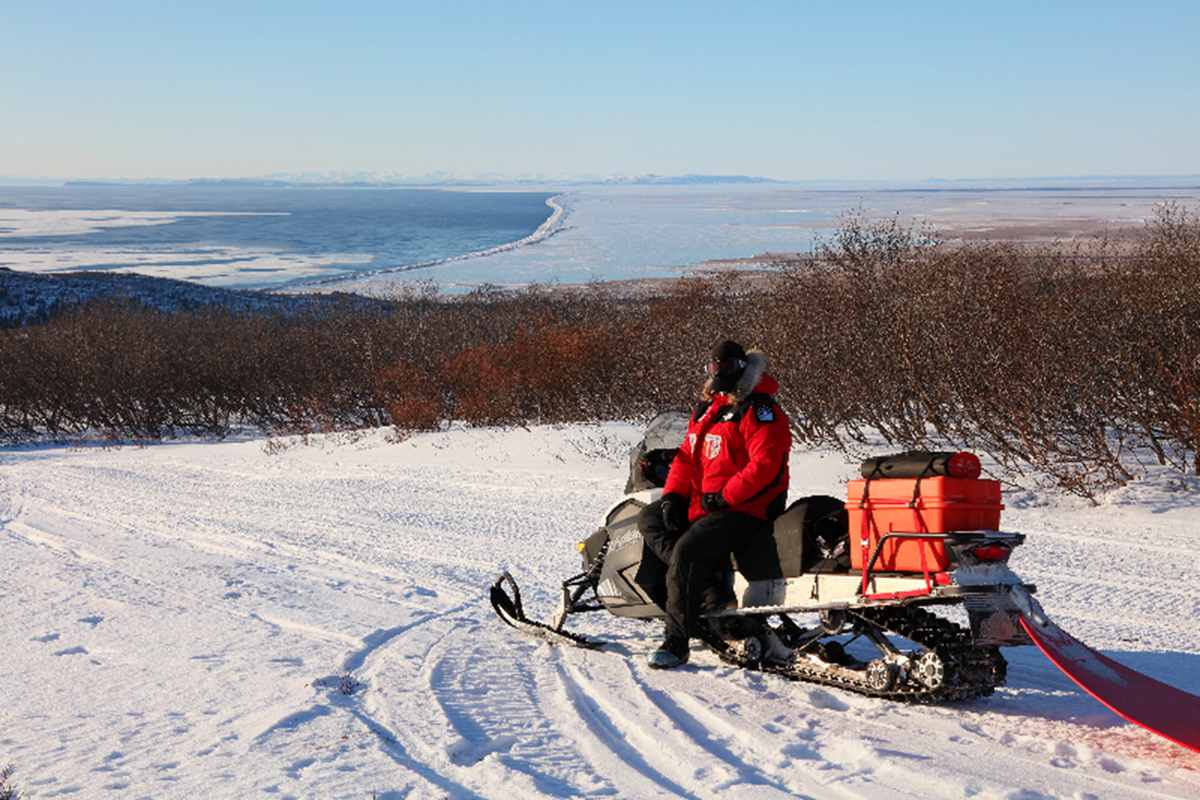
Bob Jones' complete 2016 Iditarod snowmobile tour diary follows this introduction.
For the 16th time, Bob Jones, 76, of Kettle Falls has snowmobiled the Iditarod Trail during the famous 1,400-mile Alaska sled dog race. The going has ranged from grueling to a breeze, whiteout to sunshine, bitter-cold to balmy and bottomless snow to no snow on the trail.
But he's said in email reports this month that he's loved every mile of the challenging ride from the Wasilla area about 1,100-miles to Nome by the Iditarod North Route.
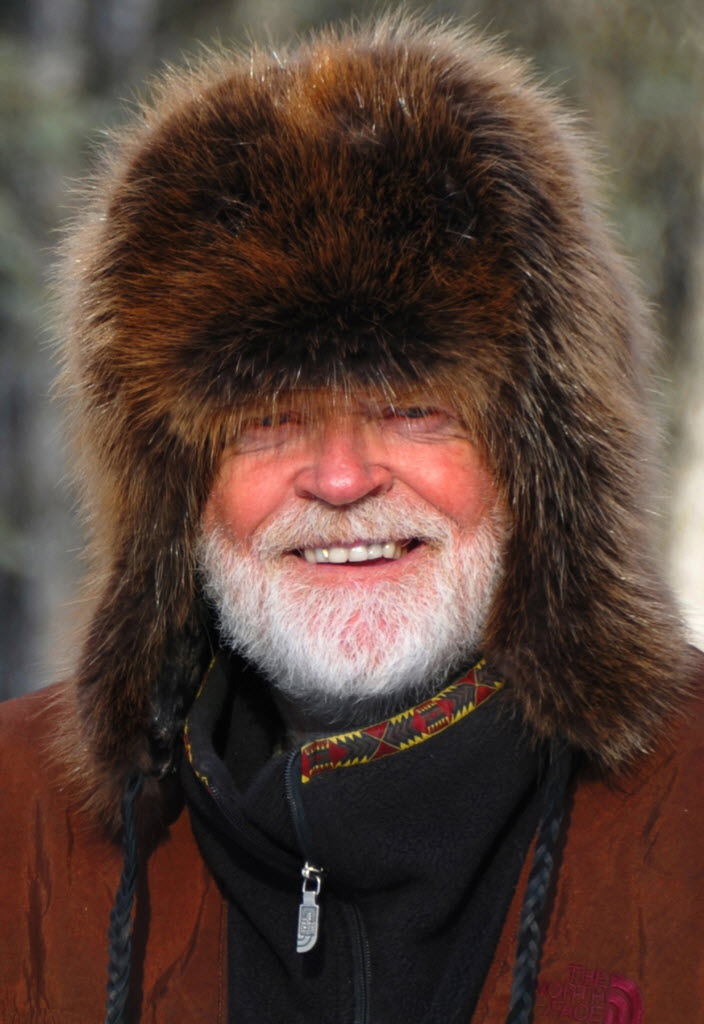
Just getting to Alaska was an adventure. “Had nine flat tires on the snowmobile trailer coming north,” he reported on March 4. “Even the old timers say it might be a record! I drove up the paved Cassiar where they evidently used arrowheads for traction sand.”
Jones and his son-in-law, Josh Rindal of Spokane, needed three weeks to complete the trip on two snowmobiles towing sleds, much as they did when the S-R followed their 2014 trip. From Nome they are now riding another 300 miles or so in a few days to Unalkleet where they could make connections to barge their snowmobiles back to the lower 48.
From the outset, they had to alter the itinerary to get beyond a lot of bare ground and mud before launching out by snowmobile this year. But miles from the normal starting point, they soon found several feet of snow and 14-degree temps.
The snowmobilers left a few days before the sled dog race started, were on the trail when the teams went by, and then followed behind the action and arrived in Nome in time to celebrate the end of the trail with the mushers.
“We had a beautiful 60-mile run the first day from Deshka to the Skwentna Roadhouse,” Jones said, noting that they had to detour around some tricky open-water areas along the Swentna River. All in a day’s work on the Iditarod Trail.
“The old roadhouse is warm, quaint and it reeks of Alaskan history,” he said. “It is a treat to camp there. Cindy met us at the door to announce she was putting our steaks on the grill. We climbed the inside stairs and found our rooms: Exactly the same as they have been for the nearly 20 years we have stayed here.
“Two 24-ounce rib steaks, twice-baked spuds, a gorgeous salad and homemade bread was presented as our meager chow! Cindy’s cooking has to be seen to be believed, and this dinner was no exception!”
He noted that the grub gets much more meager on some of the remote primitive stops, when he and Rindal might scarf a freeze-dried meal while bunked in a bare-bones BLM wayside cabin and call it good.
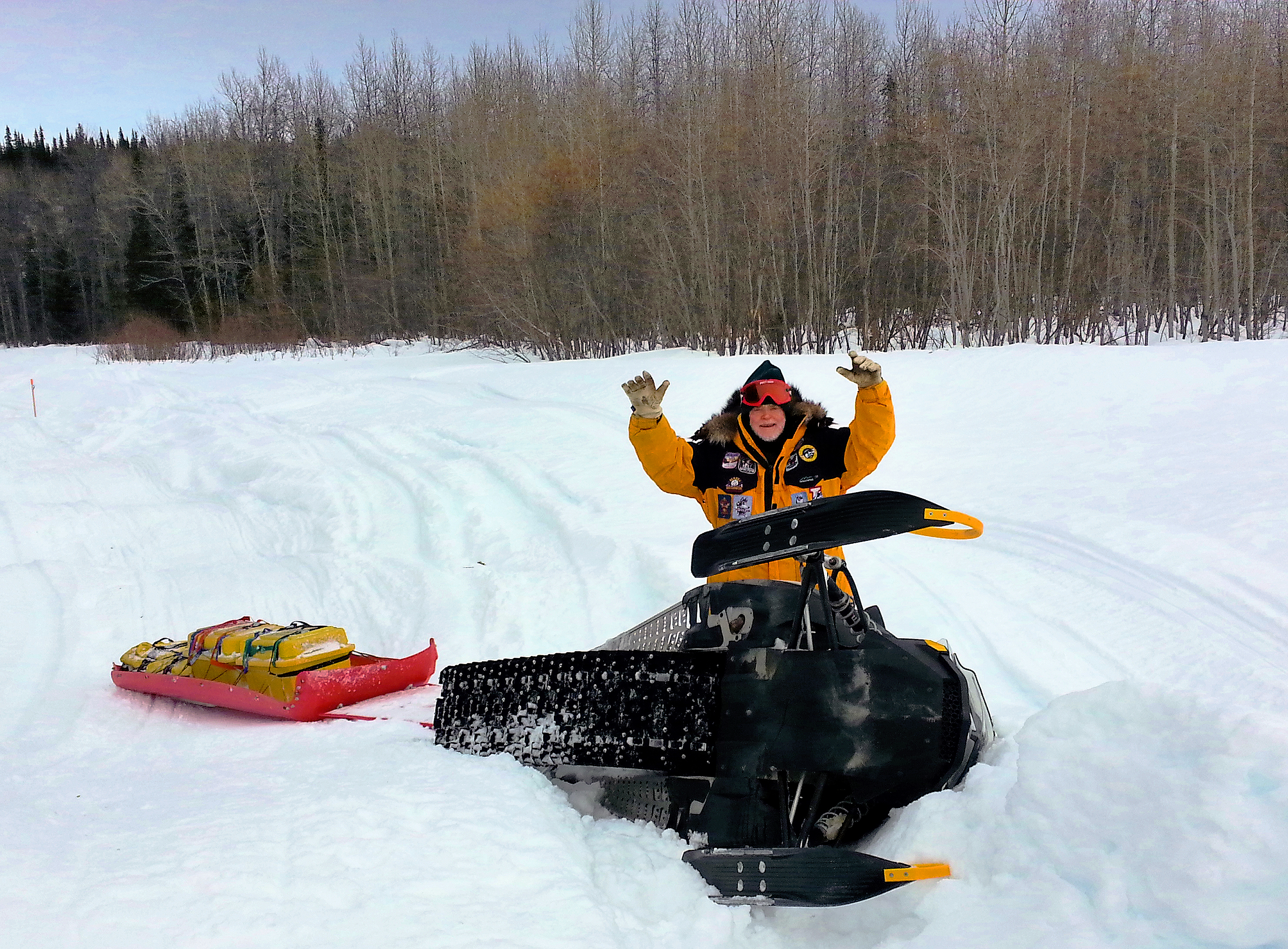
The riding became tougher, too, as Jones was reminded on the second day of the tour when he turned over his snowmobile twice in one day on rough terrain skirting open water along the Happy River on the way to Rainy Pass Lodge.
Here’s the rest of Jones’ 2016 Iditarod Snowmobiling Diary.
On March 6 (Day 3 of the trip), Jones recalled the day of riding to Rainy Pass Lodge:
I just got back to our cabin from a delicious pork loin dinner. The night sky overhead is as black as a chunk a coal embedded with a million sparkling diamonds. The big peaks surrounding Puntilla Lake look like a circle of miniature Tetons jutting up into that sky. And it’s cold! I didn’t think to check the temperature when I left the lodge, but it was +7º this morning. The clear sky will likely lower that even further tonight.
The stove in this cabin is excellent. It turns out that it’s brand new, and Josh and I are the first to enjoy a fire in it. It burned all night on an armload of wood. I stoked it only once.
This morning we decided to spend a second night right here. We made Steve Perrins, the owner of the lodge, and the father of the “Our 5 Sons” TV series, which was filmed here, a deal: We will stay and pay for an extra night. In return, he agreed to let us camp in a little log cabin the lodge maintains about 7 miles up the trail for tomorrow night.
The dog teams left Willow this morning, which means the leader will likely arrive here early enough for it to still be dark in the morning. The guests began to fly in via bush aircraft this afternoon, and the 40 or so people in the lodge for dinner tonight were excited to see their first musher. There will be people on the lake with flashlights to take that in.
“If you’ve seen one dog team you’ve seen them all” I told Josh.
“The only difference is the color of the musher’s parkas! Don’t wake me up!” until it’s time for breakfast.
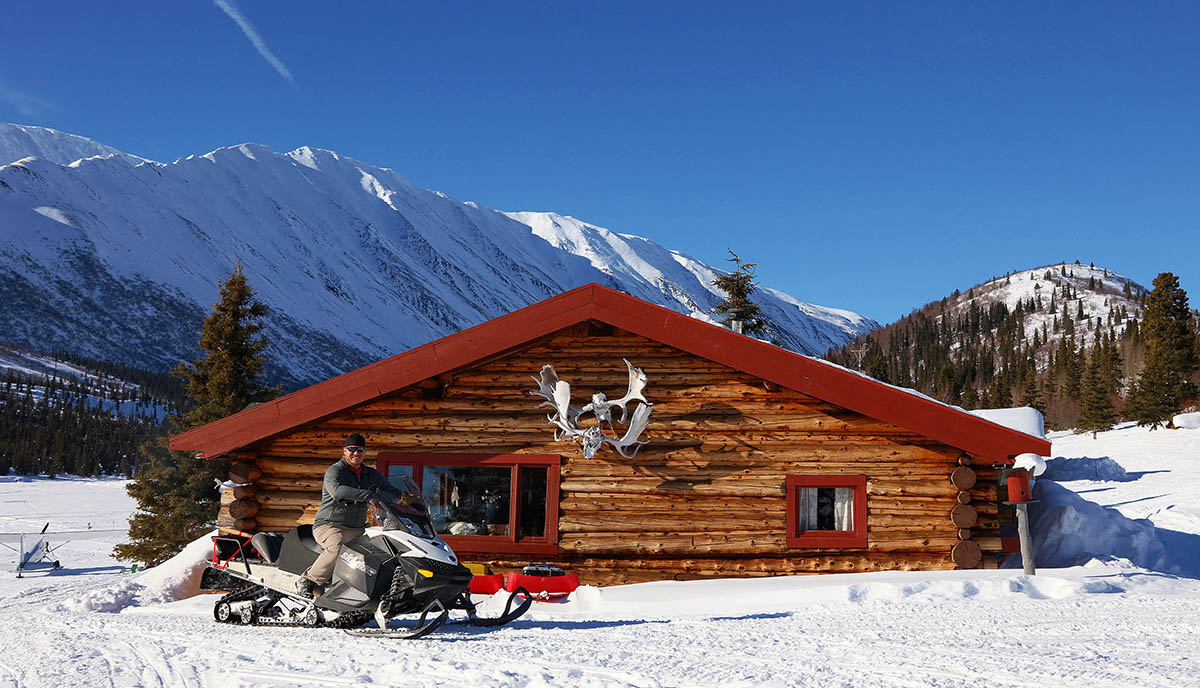
We lounged around the cabin and camp enjoying the most gorgeous day imaginable. The windows of the front of the cabin face Puntilla Lake, and the sun created a great amount of solar power.
We changed the drive belt on my snowmobile and made a couple of minor adjustments to the suspension. Around 3 p.m. we decided to make a run up the trail to check out our cabin for tomorrow night. It is visible from the trail if one knows where to look. And it’s far enough off the trail that no one goes to it during the winter. The last ones to that camp were moose hunters in September.
The snow at the lodge is a measured 42-inches and it is soft all the way to the ground. That limits the use of snow machines due to the lack of a base. But as soon as one climbs up and out of this valley the wind takes over and the snow is much harder. A snow machine can be ridden anywhere up there.
Moose had stomped the trail up in several places and there was signs of much activity throughout the sparsely timbered valley.
We rode up to the cabin and proceeded to remove the plywood door-protector. The inside looked like the last people who had left here did so in a hurry. Josh and I moved barrels of horse feed and miscellaneous stuff around until we had cleared off a little table and two bunks. The wood stove and pipe were totally rusted out. We’d have no fire. But there was a 4-burner propane cooking stove on the counter, along with what seemed like a half-full bottle of propane. That stove, along with the two Coleman lanterns on the table, would be all the heat we would have. We put new mantles on the lanterns and filled them with fuel.
Steve Perrins wanted an inventory of the food left in the cabin. And he asked us to bring back any garbage that may have been left there. Josh did a full-page inventory while I got three large bags of garbage ready to haul out.
We spent a couple of hours at the cabin and when we left it was tuned up and ready to provide us with a shelter for tomorrow night.
Jim Knight and I had stayed nights in this cabin on two of our trips to Nome in the late ‘90’s. But that had been 15 years ago. In the event that this becomes my final ride to Nome I thought it would be appropriate to spend one more night here.
We tied the trash onto the rear rack of Joshe's machine and made a quick ride back to our cabin at the lodge.
Dinner was scheduled for 7 p.m. and it was a much different situation than it was last night. Josh and I were among a small handful of people in the dining room then. Tonight the annual rush of spectators had begun, and there were 40 or more people for dinner. Rules of behavior were presented by some of the Iditarod staff. Tomorrow there will be a slug of dog teams on the ice of the lake, with hundreds of sled dogs resting after their 160 mile run from Willow. Spectators were advised to enjoy the scene while not becoming an interference.
Josh and I have company in our little digs tonight. One of the pilots of the Iditarod Air Force will be in a second bedroom.
***
On March 7 (Day 4 of the trip to Bucky’s cabin), the temperature was hovering in single digits as Jones and Rindal saw the first Iditarod musher catch up to them at Puntilla Lake.
“It was Hugh Neff, who won the Yukon Quest race a month ago,” Jones said. “He left Willow in number 70 position and had passed 69 teams to come into here in first place. He’s serious about matching Lance Mackey’s record of being the only musher to win both the Quest and the Iditarod in the same year. He didn’t stay long.”
Here’s the rest of Jones’ diary post:
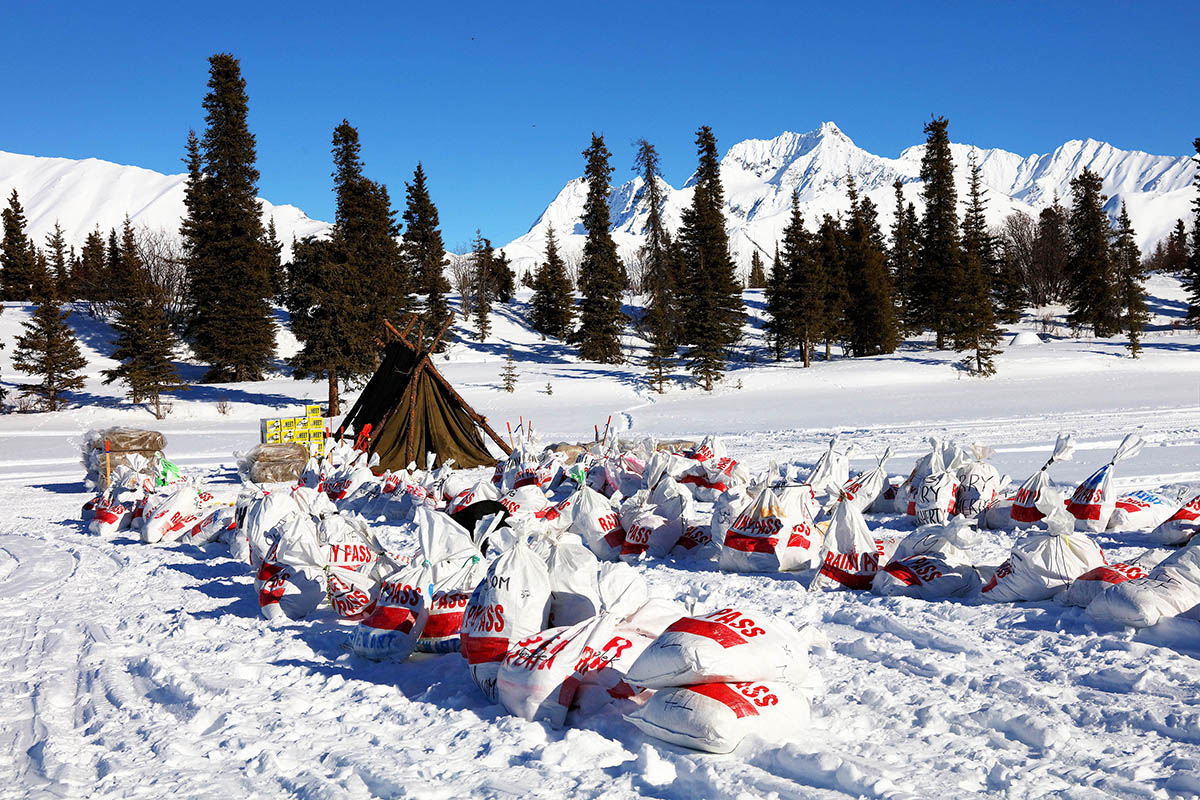
All hell broke loose on Puntilla today. There were so many bush planes on and in the air over the ice that it looked like an air traffic controller would have been handy. Two helicopters arrived with news crews.
More and more dog teams kept pouring in and the lake was covered with tourists from all over the world taking part in this celebration.
We got semi-packed up and just plain enjoyed a day that was so unique that it will never be matched.
The two snowmobilers were to stay in a rustic shack called Bucky’s Cabin, but they hung around the lodge at Puntilla to take in the excitement surrounding the leaders in the dog sled race.
“Josh and I were in the living room of our cabin when in walked a guy with a cowboy hat and a guitar case. After he made a few comments and I asked him: “There isn’t any chance you had something to do with the song “The Iditarod Trail, is there?” and he said he sure did: He wrote it! I knew right then the guy’s handle was Hobo Jim. He put his gear in one of the three bedrooms and came out with a new bottle of Gentlemen Jack whiskey. The owners of the lodge had flown him out to play for their guests this evening. For over two hours the three of us talked about hunting, music and the Iditarod Trail. And we put a serious dent in his bottle! He told us that he has over 600 published song titles, and that George Jones, Reba McIntyre and Etta James are among the many artists who have used his work.
“He signed a couple of CD’s for us and used his phone to send me some great photos of giant wolves and brown bears he has taken on the Kenai Peninsula. He even pulled out a document from the state of Alaska authorizing him to take an unlimited number of black and brown bears on a year-round basis as an effort to reduce the predation on moose and caribou on the Kenai. The guy had some of the best stories we ever heard and he had the photographs to prove them. He said he has come to the Idaho Guides and Outfitters Association annual meeting for over twenty years to play music and to support their cause. The guests at the lodge are in for a real treat tonight. But Josh and I had to be getting further north.
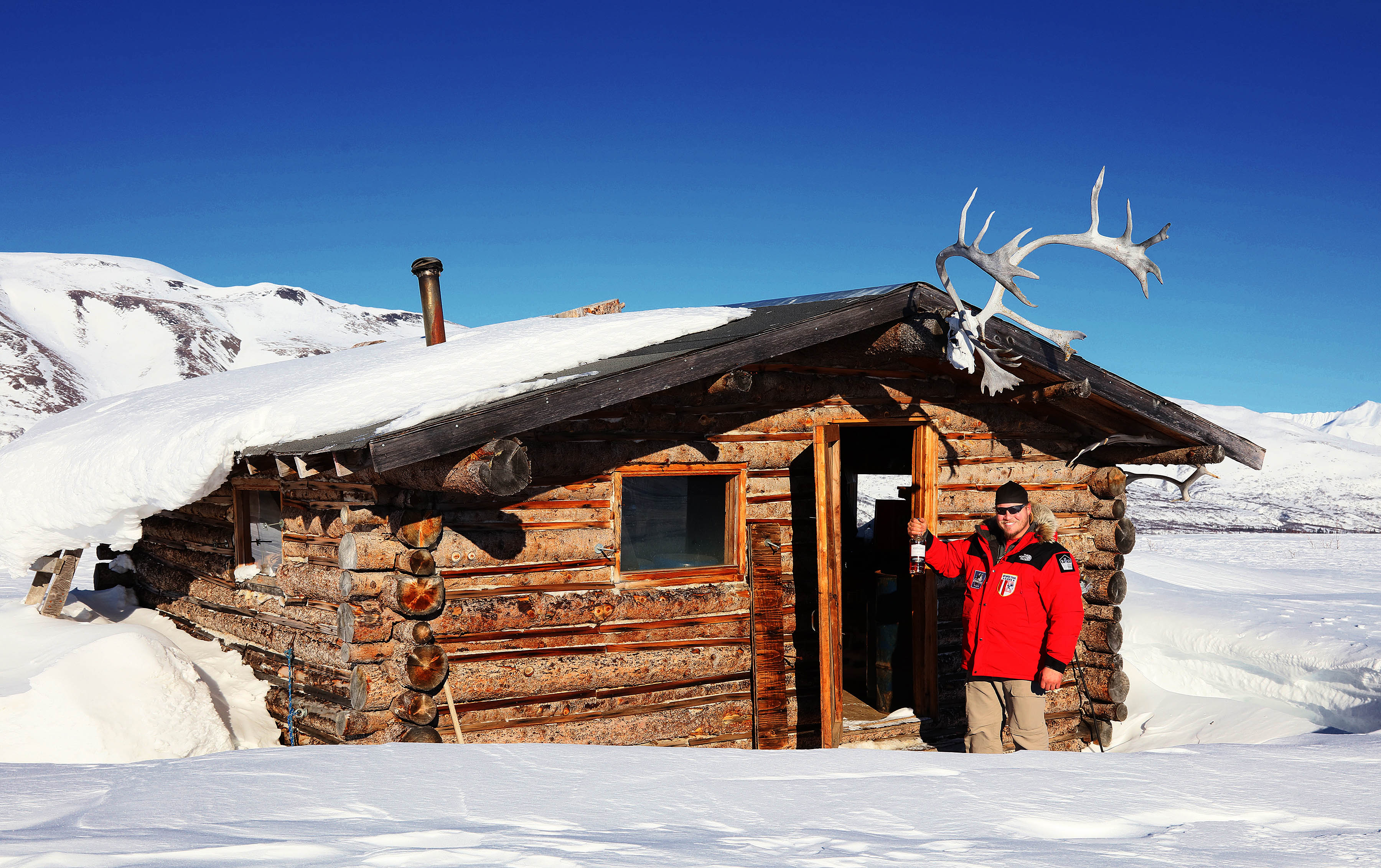
At the shack that night, Jones lit two Coleman lanterns and put freeze-dried dinner water on their little MSR gas stove while Josh packed their gear in.
The next day they would head over the Alaska Range at Rainy Pass and get down the dreaded Dalzell Gorge to the Rhon Checkpoint. That’s a distance of about 25 tough miles. From Rohn it’s another 45 trail miles to a little shelter cabin at Bear Creek.
Gas on the trail was going for about $7-$8 a gallon. They were averaging around 18 miles per gallon pulling sleds for the 1,110-mile trip in Iditarod's North Trail.
***
On March 8 (Day 5 to Rainy Pass Lake Cabin), they departed into gray skies and white-out conditions. “I was running totally blind and Josh could see a few dogs tracks ahead only if he stood up on his machine. He was picking up every dog booty he came to, and there were many of them strewn along the trail as the dogs lost them off their feet. Joshes snail-speed pace saved my bacon, because I could keep his sled about 25-feet ahead of me and it gave me a target and a sense of the location of the nearly invisible path. My old eyes ain’t what they used to be!
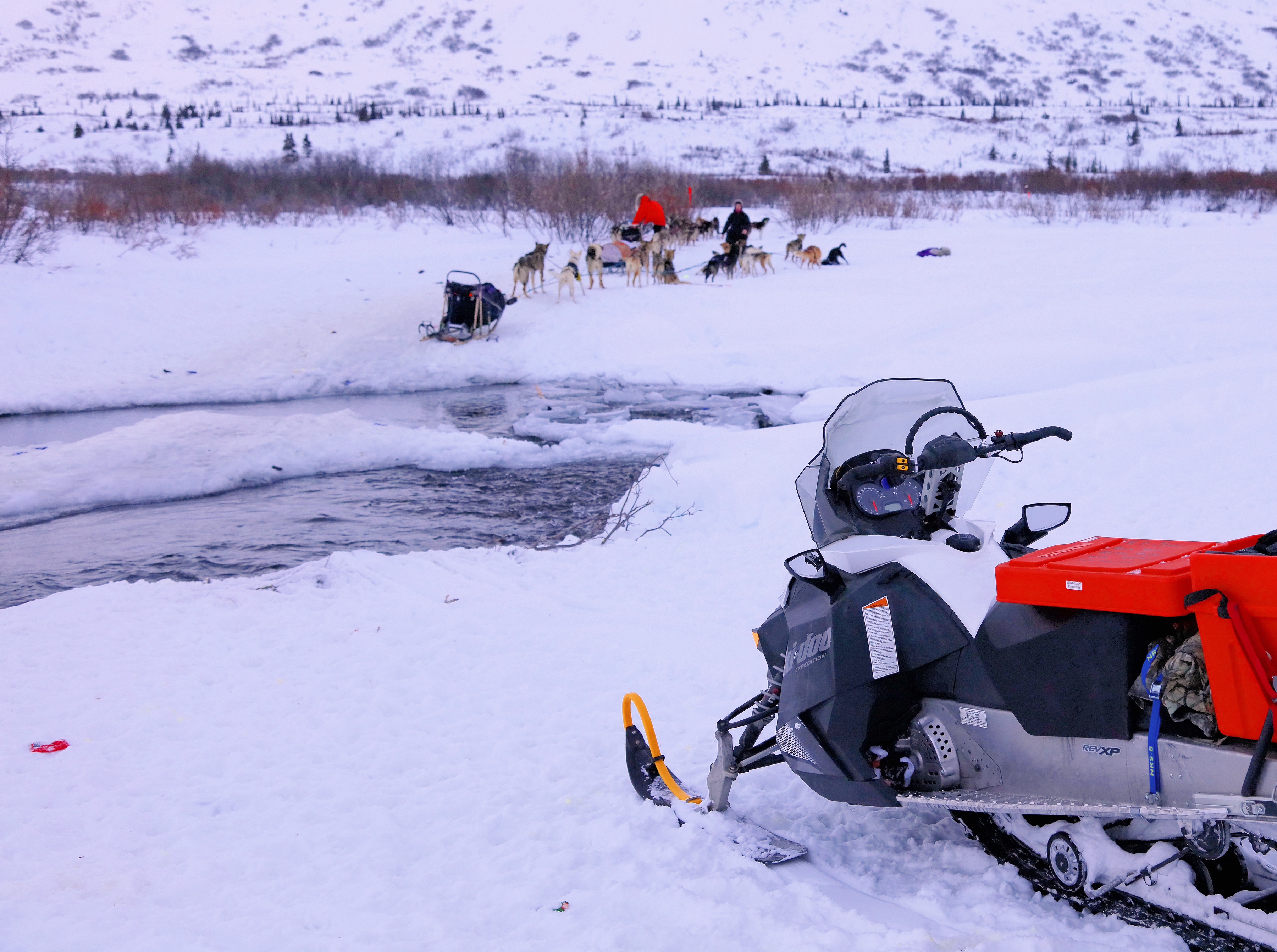
Four miles up the trail we caught up with two dog teams and two mushers who were having a tough time coaxing their dogs through a nasty crossing of the Happy River. Swift, black water 18-inches deep and 20-feet wide had washed out the trail. The first musher had just gotten across to the north bank and a little gal was standing knee-deep in the center pulling on her lead dogs harness in an attempt to get him to lead her team across. One of her dogs had gotten loose and came down the trail past Josh and me. We each tried to grab the broken tether tied to its neck, but the dog was spooked enough that it avoided our efforts. Josh went after the dog with his machine but the dog was having no part of capture. A lost dog is a serious deal during the race, and we felt bad that we could be of no help. This lost dog will, no doubt, create a stir with the media.
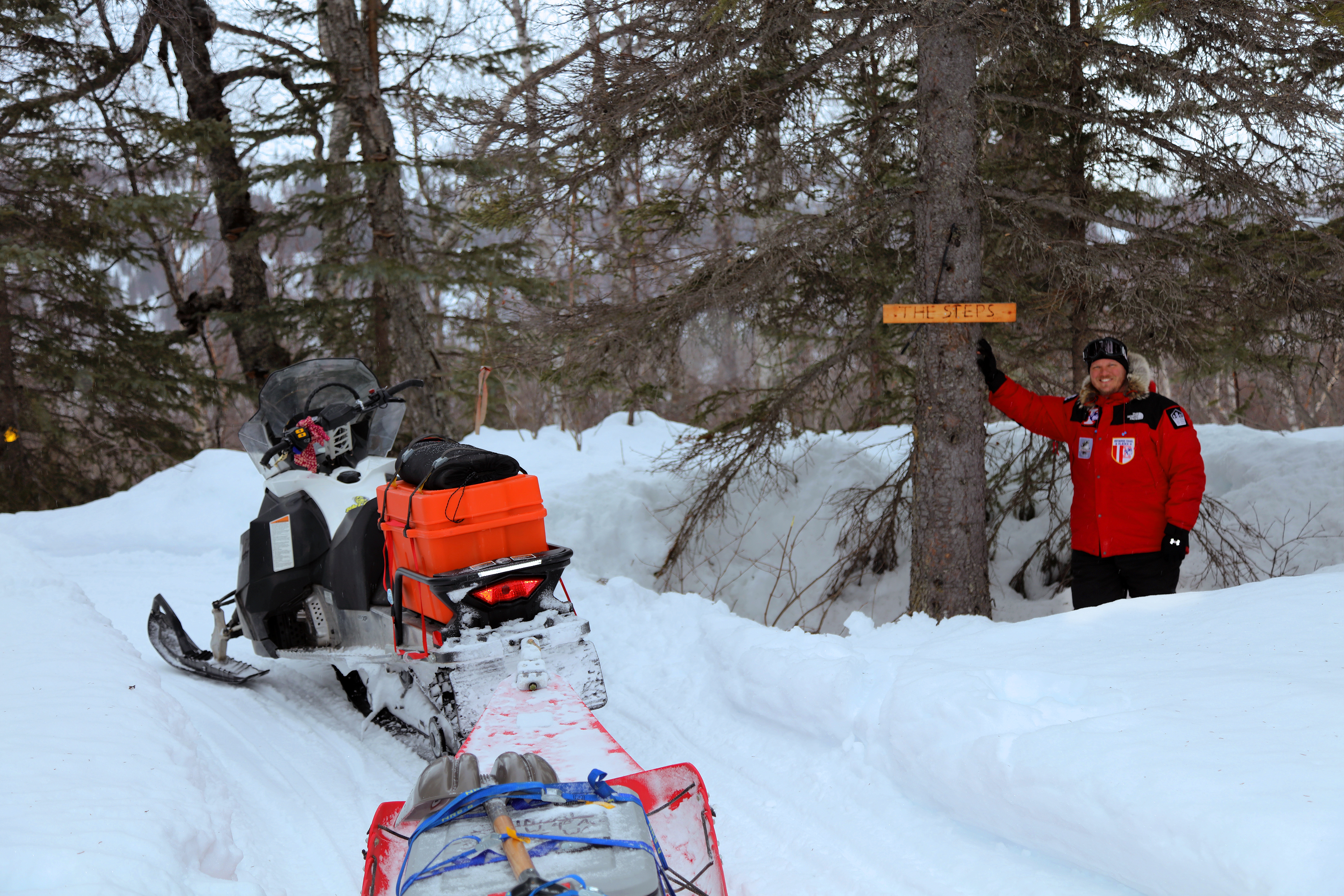
There was no way we could run our snowmobiles through this much water, and the creek had sheer banks and was deep and open for as far as we could see both up and downstream. Josh unhooked his tow sled and headed up the valley in search of a snow/ice bridge. It wasn’t long before he rode in with a thumbs up signal. He had found a solid crossing a half-mile above the wash-out..
It was a little tricky navigating the deep snow and the dense willows, but we eventually got across the new crossing and returned to the real trail.
The day was warm, and the deep snow caused the trail to be ‘punchy’. We stopped to take a little break: We had come only five miles in three hours!
Our plan to make the Bear Creek BLM Shelter Cabin, about 60 miles up the trail, for tonight was going down fast. The next logical camping place between here and Bear Creek would be Rohn. And that it would be a zoo with all the dog teams streaming into there.
We had one other potential ace in the hole: The little cabin at Rainy Pass Lake lies just under the pass on the south side. We could pull in there for the night and let the remaining dog teams pass us there.
We rode up the trail until we could see the little cabin across a frozen lake and against a steep, wind-swept bare hillside.
We rode up and opened the door. It didn’t look like anyone had been there this winter. The chinking between the logs was missing in a hundred places and there was 18-inches of snow in places on the floor. But it had a barrel for a wood stove, a supply of firewood, and it had walls and a roof. We decided it was good enough for us! Another thing may have added to our decision: We had taken shelter here a couple of times on years previous, and the little ass-out place had given us some pleasant memories. So we unpacked and moved in: We had made 10.3 miles today!
Josh found some insulation upstairs and he took and hour or so to plug all the holes in the walls. And our snow shovel made quick work of cleaning up the floor. This cabin is only 5 or 6 years old but it looks ancient. Steve Perrins and the ‘My 5 Son’s crew dragged the unpeeled spruce logs up here with horses in the summer and snowmobiles in the winter. The cabin is 15-feet by 15-feet, the maximum size allowed by their permit. But the permit didn’t say anything about a second floor, so the boys added one. Going up was OK. Going out was not.
I came by here on one of my solo trips to Nome and found the second-story blown off the building, full of snow and lying upside-down on the hillside above the cabin. Now that was a spooky site! I figured that was the end for the cabin. But the boys came up the next summer and, somehow, pulled the second story back into place with their horses! “we nailed it down a little better the second time” was their story.
We spent some of the afternoon working the cabin over, and by a 7 p.m. dinner-time we had it real cozy. The old barrel stove needed a steel knife to keep the door tight and the we covered the lower vents with foil. The installer had been smart enough to put a good damper in the stovepipe. That gave us the air control we needed and we kept the fire at a minimum. We didn’t use much wood, which is pretty hard to come by up here. And we created some heat by burning all the old junk and trash we could find. This is sheep country, and the nearest spruce tree is at least ten miles downtrail. Any firewood one finds here came in on the back of a pack horse. The horse that packed this wood up here will no doubt appreciate the fact that we will let the fire go out tonight.
Josh reported +21º on the porch at 8pm. Downright balmy for this time of year.
A quiet and peaceful night is in store for us in this little cabin in the Alaska Range.
***
On March 9 (Day 6 to Bear Creek Cabin), Jones and Rindal were getting ready to set out when four snow machines pulling huge trailers of gear went past: The Iditarod Trail Sweeps. That meant the remaining racers had passed them.
“We caught up with them at the Rainy Pass Sign, shook hands all-around, and had a good BS session. They were, as usual, in a hurry so they didn’t dally long.
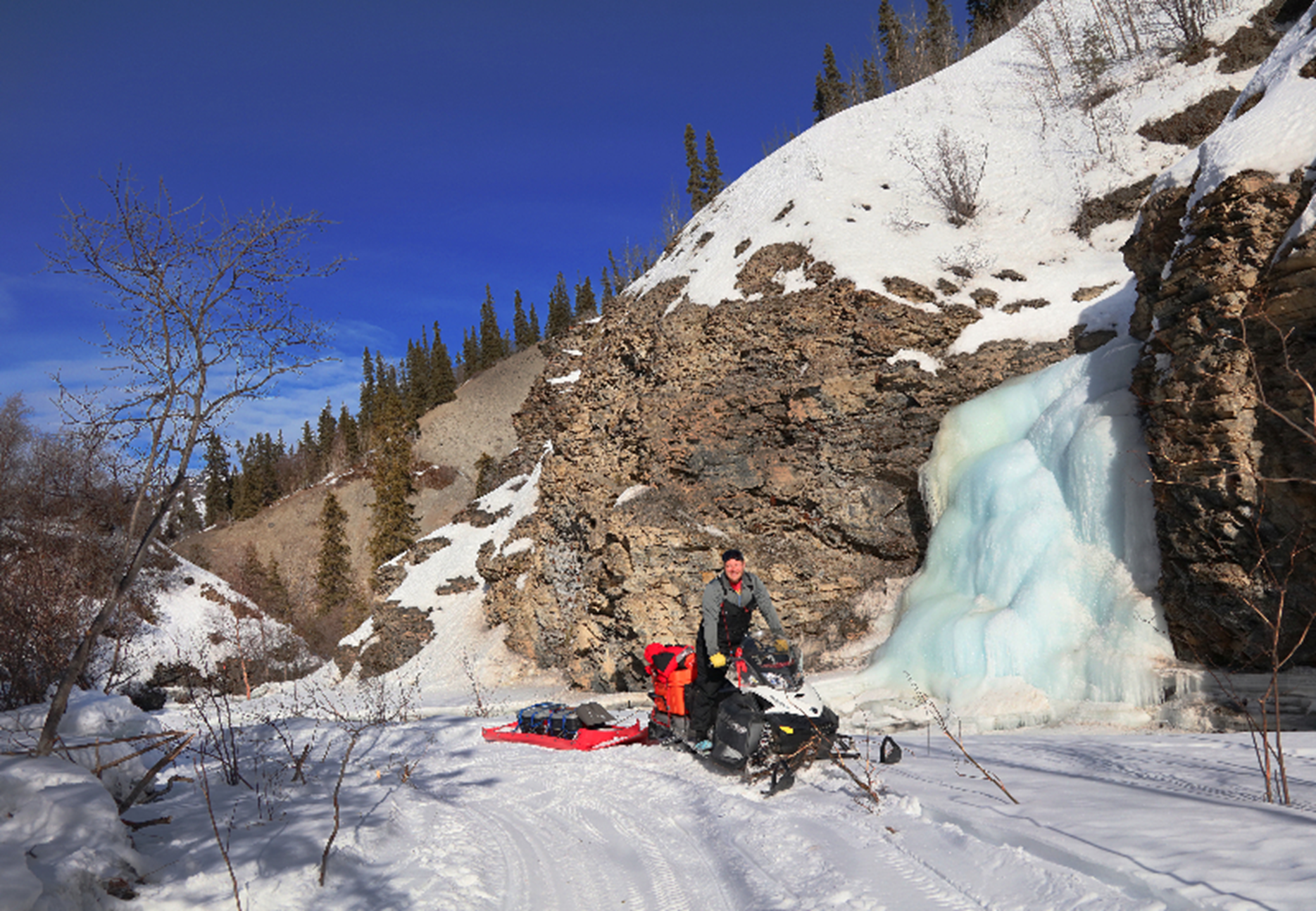
The 16 miles from the cabin to Rohn includes the Dalzell Gorge When you ride a snow machine through this section you tend to wonder just who had the tenacity to think a trail could be put in here. It is some severe country. The Trail Breakers had spent eight days in this section in 2016, and their efforts included the construction of 37 ice bridges over running streams. It is the bottleneck of the Iditarod, and it takes a great deal of work to have a trail ready for the dog teams.
We made it through the Gorge and out onto the comparatively flat ice of the Tatina River and into the Rohn Cabin Checkpoint: 16 miles in three hours. Josh picked up dog booties all the way, and there were hundreds of them.
The old crew at Rohn, who we had come to enjoy over the years, has thinned out and it was easy to leave after a single cup of coffee. We waited for the Sweeps to ride out ahead of us and left 2:30 p.m. for a 44-mile ride to our destination for night: A little 12x16 log BLM cabin at Bear Creek.
We had only gone a few miles when we found The Sweeps spun out and stuck, from end to end, in a tight, steep little ravine where we’ve have had a lot of difficulty over the years. Josh climbed up and helped them pull the first machine up the hill with a rope winch. A strong rope was attached to the tow sled and it was pulled up, using that machine. The process was repeated until all their machines and sleds were up on top. Then Josh made a mighty run up the ravine with his machine and made it just fine. He then walked back down to my outfit and ran it up to the top with no problem. The Sweeps had cost us a couple of hours of daylight.
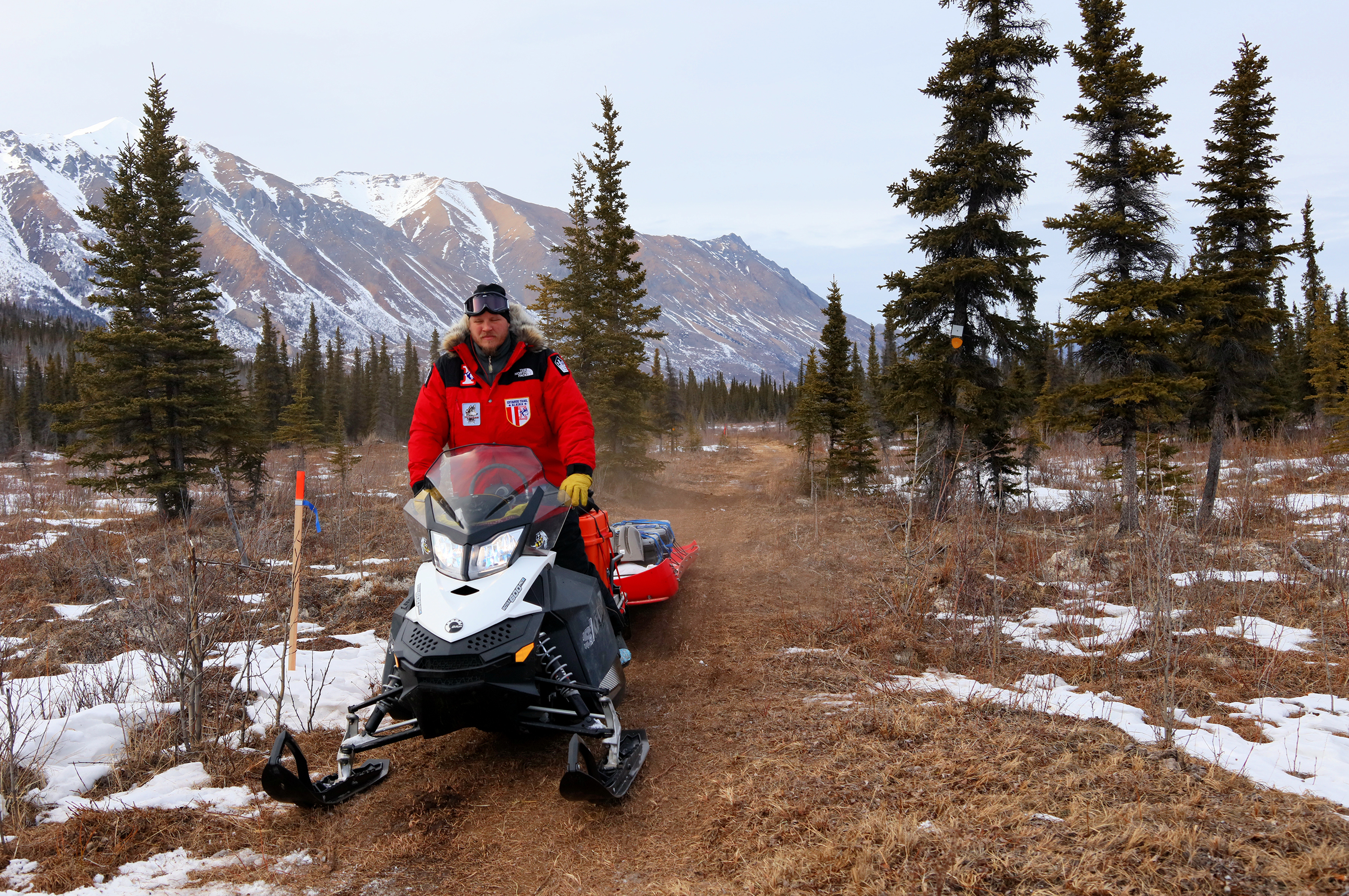
Eight miles north of Rohn is the crossing of the Post River, and at this point snow conditions changed drastically! The trail here runs mostly uphill to the north. The sun travels from east to west each day. And the giant Farewell Burn of several years ago eliminated the dense spruce trees and hence shade for the trail. Add to this the fact that this valley is a ‘Chinook Trap’ causing periods of higher than normal temperatures, and the sparse snow that falls is subject to getting cooked off.
We had about 14 miles of trail that not only had no snow, but it also had a couple of inches of dust and lots of rocks on it. No snow in the burn is the common condition. We rode other shorter sections with no snow also, so we had about 20 miles of totally bare ground to cover. It wasn’t a nice ride!.
We caught up with Sweeps again at the Post River Glacier. They had spun out on another steep hill, but this time it was their third-in-line machine that failed to make it. They had the advantage of having a pulling machine up on top, and it didn’t take nearly as long to get up. Once they got out of the way Josh and I had little problem making the hill.
We got a surprise at the Post River Glacier. This year there wasn’t one. We have found it huge and difficult to get around, and we have found it smaller and easier. But we had never been here when it didn’t form at all. We had to run on big, shale rocks where normally there would be ice up to 100-feet thick.
We began to find patches of ice on the trail after we got past Egypt Mountain, and by the time we got to Farewell Lake there was pretty good snow. It was hard and it was rough. But at least it was snow.
We knew that dry wood is a rare commodity around the Bear Creek Cabin, so Josh and I stopped, got our chain saw out to cut some dry, fire-killed spruce leaning right over the trail. We were still 20 miles from the cabin but here was good wood and it was daylight.
We had some nice logs tied to Joshes sled when the Sweeps came by. We caught up with them at the site of Runkle’s old Buffalo Camp. John Runkel and his family had a bison hunting situation here for many years. It was the finest tent camp I have every seen, and there were several years we pulled in and were invited to dinner and a warm sleeping tent. It was more than a little sad to watch it go back to nature. We passed the Sweeps once again, and we arrived at the cabin at 10 p.m. Temperature as 18 degrees. We had a fire in the stove and a lantern going when they came it.
We’ve gotten to know these people pretty well over the years, and it has been on only a few occasions that we have shared a camp with them. It was an enjoyable evening.
***
On March 10 (Day 7 to the musher's tent at Nicolai) , the 34-mile run to Nicolai entailed a nice day and plenty of snow on the trail, for a change.
When Josh and I came through in 2014 the race was past this point, and they had just taken down the musher’s tent. This year I called John Runkle and told him we should be coming through on Thursday. “The musher’s tent will be all yours. We’ll leave it up for you!” That kind of hospitality is hard to turn down.
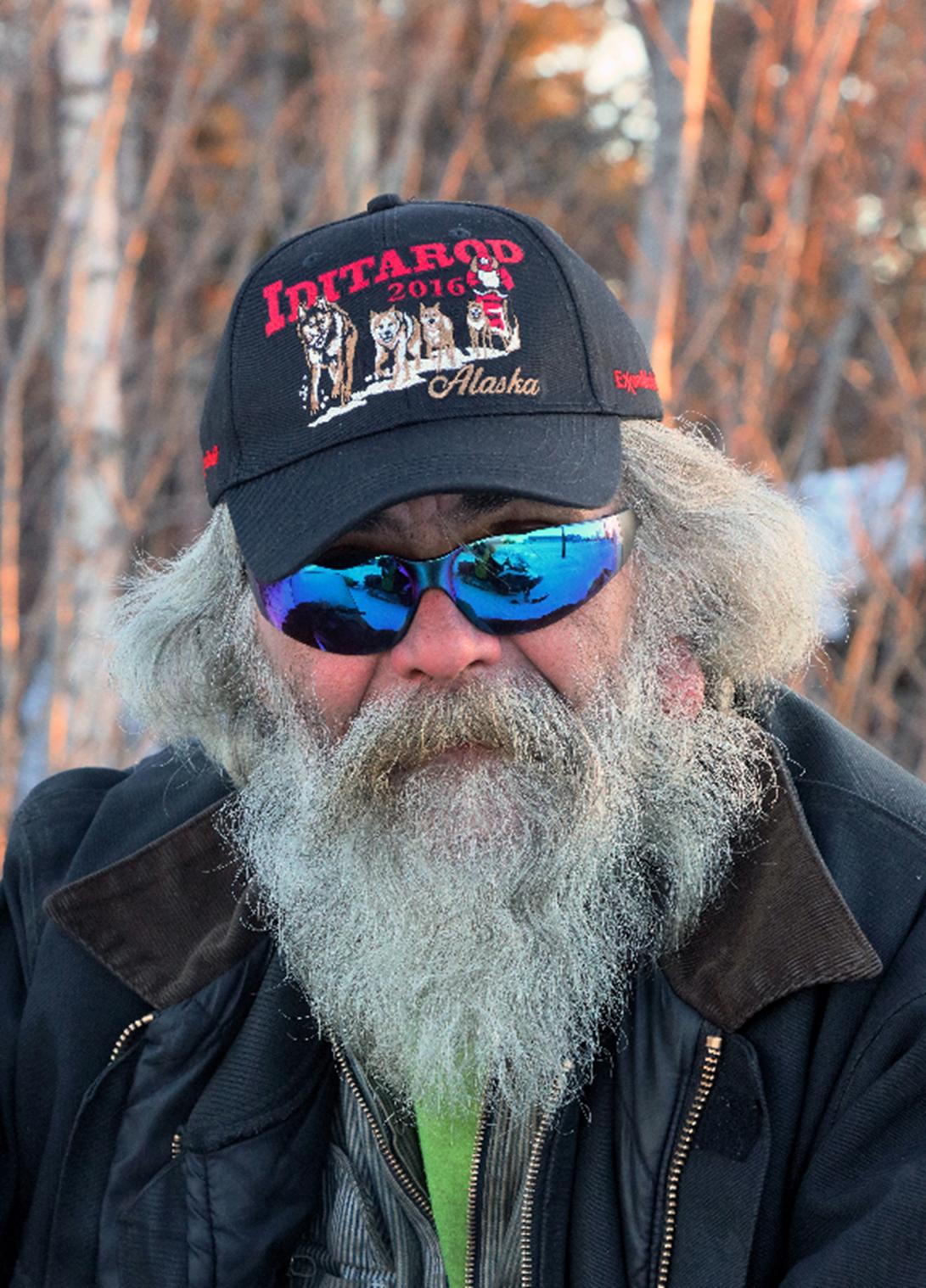
We crossed the Sullivan Creek Bridge and made our way to Salmon Camp on the Salmon River. Jim Knight and I took shelter there in an old cabin during a blizzard 20 years ago. I’ve photographed that old shack every trip by since, so I have a two-decade record of a cabin slowing going back to nature. Since 2014, the decay has accelerated. The roof has fallen in and it won’t be long until it’s completely gone.
We pulled into Nicolai at 3 p.m. under clear skies. Two dog teams remained, each taking their 24-hour rest period. Billy Snodgrass of Dubois, Wyoming, was one of them. I reminded him that I had taken photos of him in Kaltag years ago.
Big Ed Sellerd came by on his ’79 Ski-Doo double-track Alpine II. We asked him about fuel and he immediately went to the city office for the key to the pump. My machine took 7.5 gallons for 107.2 miles from Rainy Pass Lodge. Josh had 111 miles and 7.6 gallons. That resulted in a fuel mileage of only 14.3mpg. That’s the worst mileage we have ever gotten with these machines and it was probably due to all the bare ground we had to drag our tow sleds over. Fuel here all comes via airplanes and was $7 bucks a gallon.
A stream of old friends was coming by and they told us we were welcome to go to the school for some chow. The little kitchen was named “The Iditarod Café” for the few days of the race each year. The food was great.
We moved our gear into the Musher’s Tent, where we found a thick bed of fresh spruce bows on the floor, two cots, a couple of chairs, a table and a dandy wood stove complete with enough wood to last a week. John and Marty Runkle came by by for a nice chat. They were tired from the go-man-go of the past several days.
We would be having official company later tonight until the final two mushers would leave Nicolai, headed the 52 miles to McGrath.

Damian Dennis (Nick’s son) has been checking at this checkpoint and he told us that the first musher into here was Nicolas Petit at 8:31a.m. Tuesday. They had 58 teams come in here that day. The last-place team will be out at 1:30 a.m. Friday, meaning the entire race passed through here in a total of only 65 hours. And only 4 out of a starting field of 85 mushers have scratched as of this time.
Damian checked the last musher of the 2016 hoard of dog teams out of Nicolai at 2:31a.m., and she headed into the darkness towards McGrath. It was +6º when she disappeared under a huge green band of dancing Northern Lights.
This village of only about 100 souls, located on a river bank at the head of the Kuskokwim River, really comes to life during Iditarod and every native is proud to play a roll. Martin Buser was so impressed with his treatment here that he named his first son Nicolai (the second is Rohn).
***
On March 12 (Day 9, at McGrath) Stephen at the Man Cave in McGrath brewed us up one of his famous breakfasts: Hotcakes, sausage, bacon, hash browns, toast and hot coffee. WOW! The best of the trip. Josh and I each took very welcome showers. And I put a load of clothes in the washer.
After a couple of hours of BS it was decided that we needed to snowmobile up the Tokotna River to Steph’s moose hunting camp for a look around. It was a gorgeous day and a ride was perfect.
Josh and I and Steph and a box of Miller Lite made short work of the 9 mile run. A fire was soon in a big wood stove in a good-sized camp unit that had been drug up the river with a CAT the winter before. The unit was a little crude but it was also perfect. The nice little birch-covered flat above the river made for a great hunting camp. There is a huge open area adjacent to camp and the moose are plentiful.
Back at McGrath a few hours later, Melody had fried chicken, shrimp, salad, asparagus and mashed potatoes and gravy waiting for us. These people really know how to treat visitors!
Before we knew it, daylight savings time had kicked in and it was after 2 a.m.
***
On March 13 (Day 10 to BLM Cabin at Carlson’s Crossing of the Innoko River), Gus came by for breakfast and the Man Cave. He stuck around to lend a little help checking out our machines. They hadn’t really had any TLC since we were here two years and 1,400 miles ago.
The morning was overcast and warm with no wind. I’ve been in McGrath several times when the temperatures dipped to -40º during Iditarod. But today it was a pleasure just to be outside. The four of us spent an hour greasing, checking track tension, adjusting headlights, and just simply inspecting for wear and tear.
We had two stops to make: I needed to go to the Airport Café to pay Todd for six steak dinners (25 bucks each -- a bargain!). Then we needed to fuel up for the trail.
The leg from McGrath to Ruby is right at 200 miles long, and there are NO facilities out there. We filled our machines and filled two 5-gallon fuel jugs, one each.
The fuel station had one pump with two handles: Diesel and regular. The price on the regular was $7.462 per gallon.
My machine took 3.445 gallons for the 73.3 miles from our filling in Nicolai. That calculated to a fuel consumption of 21.23 mpg. Fantastic for a snow machine!
We rode away from the pump at exactly 3 p.m. with around 70 miles of trail ahead for the day (and night!).
McGrath is a HARD place to get out of!
The day had began a little gray and it stayed that way the 18-mile run to Tokatna, the last village we would see until Ruby. There are only a handful of people here and no facilities. It is a checkpoint.
The trail to Tokotna was rough and slow, as usual, with lots of deep moguls.
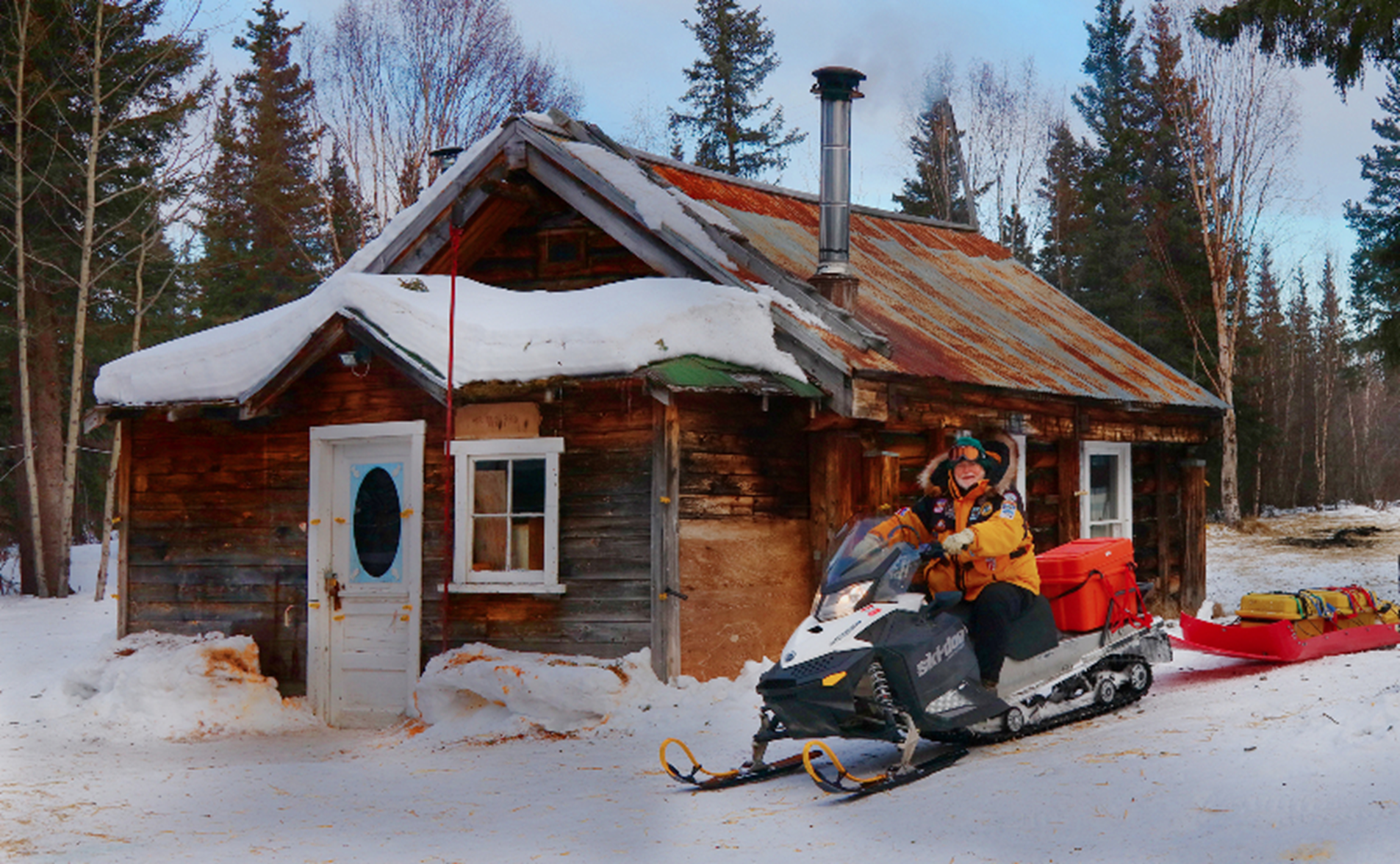
Forty miles out, a single little log cabin left over from the gold rush days serves as the Ophir Checkpoint. Smoke rose out of the stovepipe, and the last two Iditarod volunteers were just padlocking the front door when we rode up at 6:30 p.m. The couple had an ancient Ski-Doo as transportation to their airplane a mile or two down the trail at a friends cabin, and they were headed to their home in Anchorage.
We took a couple of pictures and departed at 7 p.m. with 30 miles to go to Carlson’s Cabin.
Seven miles later we came by the junction of the North and South routes of the iditarod Trail. I call the South Route the “Big Empty,” because, until this year, I have never seen a single bit of use going that direction. With the exception of the every-other-year of the race there is zero traffic the 130 miles toward Shageluk. This year there was a new mileage sign on a tree, and a track headed south. Perhaps a trapper.
It got dark an hour later tonight, but when it did the roughness of the trail was far easier to see with the headlights on the machines. It felt like it was easier to run along.
The trail was pretty rough from Ophir north. And I was surprised at how the snow depth decreased as we approached the cabin. We rode into the nearly-bare front yard at 10:15 p.m. and 67.9 miles showing on my odometer. It felt mighty good to crawl off the machines after a 7 hour and 15 minute ride over some pretty rough trail.
The cabin looked mighty good looming out of the black, as usual. The inside was a little rough this year. I started a fire in the barrel stove while Josh broke out the chain saw and made stove wood out of the few bigger pieces left outside. Old, burnable junk and trash quickly got the cabin nice and warm. And the boys from McGrath had left a Honda generator for lights.
We rolled out our bags, gobbled down a couple of Mountain Houses and got ready to crash. I shut off the generator at around 1a.m. Joshes thermometer showed +24º when we got in: Downright balmy!
***
On March 14, (Day 11 to the Cook Tent at the Cripple Checkpoint)
+14º on Joshes gadget at 9:30am. The sky was a dark gray from horizon to horizon, and it stayed that way all day. A fairly brisk headwind blew in from the northwest.
Josh poured the eight gallons of fuel we brought from McGrath into our machines. They took all but about a cup of it, he said. The rest went into the generator.
We ate breakfast and worked slowly at getting ready to go. We made a big pile of wood next to the barrel stove, packed up our gear, and were ready to ride out. Our final chore was to sweep the floor. The little shack looked far better when we left it than it did when we came in last night.
We rode out at high noon.
The trail from McGrath was, by far, the poorest I have ever seen it. The Iron Dog racers use this same trail, and snow conditions this year allowed them to make a mess of it. The surface was as hard as stone, and there were a million moguls that were deep and close together. It was rough. It was hard. And it was slow.
We crawled along, and were down to 5 mph for long stretches. The lack of snow in this country was a real surprise.
Josh was picking up just about every dog booty on the trail, and I got the ones he missed. Hundreds of them.
We took a break at the North Fork of the Innoko BLM shelter cabin., 41.8 miles above Carlson’s. It is a very nice little shelter and we talked about camping there for the night. But we decided to go on up the trail seven miles to the Cripple Checkpoint. The Iditarod Committee has a small 6-tent city at this point.
Josh and I got into Cripple at 7:30pm after riding 50 miles in seven and a half hours. And the only break we took was for a few minutes of checking out the North Fork Cabin.
The camp was deserted, or course. Just as soon as the last-place musher left here the Iditarod Air Force moved and whisked everyone up the trail. When the race is over in these isolated checkpoints, its OVER. Which was perfect. We had the place to ourselves.
The cook tent door was unlocked and the area was immaculate. It was obvious that whoever the boss of this tent is, he knows his stuff. An oil heater stood inside the door and a small barrel of oil was soon hooked up and the stove lit. We would be as stingy as we could with the fuel, because we know how difficult it is to get it here.
Josh went for some snow to melt for dinner water while I set up my little MSR stove on the table. It didn’t take long to gobble two freeze-dried dinners.
We are both amazed at how fast the time goes by out here on the trail. It flies!
Sleeping bags and pads rolled out on the floor will be our bunks for tonight.
We are 115 miles and 15 running hours north of McGrath, over a horrible trail, and we are ready for some sleep!
I just checked the thermometer and it reads +14º at 9:45pm.
***
On March 15 (Day 12 to Ruby and the Wild Iris B&B), a semi-clear sky greeted us at Cripple this morning, and the thermometer read a hard -0- when we got up. I set the oil stove on low when we turned in last night, and it was +38º in the tent when I crawled out of my bag on the floor at 9 a.m. A little increase in the volume of oil to the fire quickly took the chill off as we got dressed and packed.
We buttoned up the tent and rode off at 11a.m. Our goal for this day is the Ruby Checkpoint, 75 miles up the trail. The North Route terminates when the trail runs out onto the frozen Yukon River here.
We continued to slowly bounce and hammer our way up the trail. In many places the trail was nearly devoid of snow, and tall frozen muskeg hummocks stuck out like bowling balls. 5 mph was a top speed in these sections. The day stayed pretty cold, with a calculated high of around 12-14º. But we had one great bonus: Sunshine! Both on the trail and on our backs. It provided the best visual definition of the trail the entire trip. And the tiny amount of heat coming into our clothes was super.
After 35 miles of torture we finally arrived at a little caved-in bridge, partially submerged, with one end under a couple of feet of ice. This is Monument Creek, and the shot-up old sign says “Road Closed!”
But from this point northward the trail gets much better. A primitive road, maintained by the state of Alaska, and by the City of Ruby, leads 40 miles to town.
Winter traffic is near zero, and summer traffic is probably about the same.
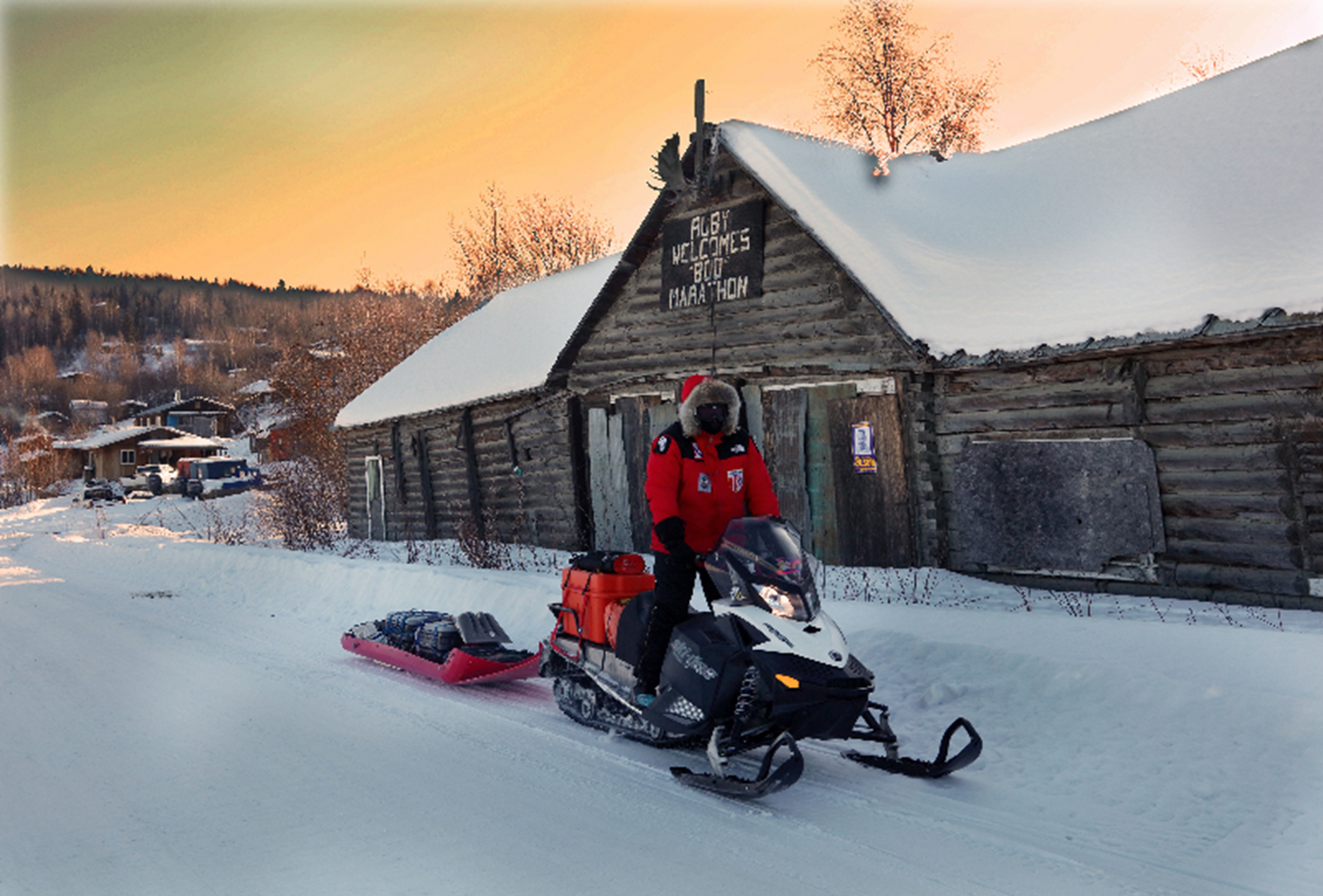
This is deep snow country, and we’ve had our share of problems through here. Not today though.
It took us a little over three cold hours to get from the bridge to Ruby, and we pulled up in front of our 2-bunk log cabin at the Wild Iris B&B at 7 p.m. I was having trouble with zippers because both hands were in a stage of numbness. Probably a combination of the cold plus too many hours of hanging on!
As Josh and I moved in, Racheal Kanges, our host, hollered off her porch next door that dinner was ready. And how it was ready! A giant plate of the best meat loaf in Alaska, along with mashed spuds, green beans, fantastic gravy, and hot home-made biscuits was our welcome to Ruby! It was (almost) worth the ride!
Her family joined us for dinner. Her dad was there. “I know this guy from somewhere…” I thought. Later it became clearer: He’s the fuel guy who’s pumped our gas in Ruby for twenty years! He laughed and popped open a couple of cold beers for Josh and I.
A quick indication of the condition of the North Route trail in 2016 would have to take into consideration that it took us about 23 hours of hard running to make that 190 miles of trail: That’s an average speed of only 8.2 miles an hour.
The trail of 2016 has, for the most part, been the total shits! And it doesn’t sound much better ahead: Racheal’s dad told us the trail the 50 miles from here to Galena, which is every-foot on the Yukon, is really rough this year. Then, past Galena, the trail leaves the river and goes for 31 miles overland to avoid open water. In normal years the Mighty Yukon can be a speed run.
Our little cabin is dry, meaning it has no bathroom. But it has a good oil heater and electricity, a great bunk, and it’s warm and quiet. And it’s 190 miles north of McGrath. Ruby is 75 miles past the halfway point of Cripple.
On March 15 (Day 13 to the City Office Building Lodging in Nulato) the day dawned bright and cool in Ruby, -6º at 8 a.m. Racheal scheduled breakfast for 9 and we were packed up by that time. We ate and made the final adjustments to riding out: We would be wearing more clothes today, as our ride out of here would be on the Yukon and, hopefully, at a much faster pace than 190 miles from McGrath to here.
What a difference a day can make! Up until yesterday, we had spent most of our first 12 days on the trail in varying states of torture! Today the entire situation changed. The Yukon had twisted and frozen and thawed and re-frozen, leaving a surface with a lot of character, but one not too conducive of snowmobile trails. The result was that most traffic had been confined to a 6-foot wide corridor, and machine use served to flatten the trail and to make it smoother.
At 11a.m. we ran right out of Ruby onto the best trail we’d had the entire trip, and it was about to get better!
Eight miles down river the trail entered an area of sand bars and blown sand and it stayed that way for about 10 miles. After that it was pure white, smooth and it even had a little pad of fresh snow for a cushion.
We picked up dog booties and enjoyed the 52-mile run to Galena in three and a half hours. We went to the little store there and ate lunch right off the shelves.
By 3 p.m. we were back-tracking east trying to find the Iditarod Trail and the checkpoint. It had been relocated this year, mainly due to the fact that the Yukon River was thin and open below here and the trail went over the “Portage Route”.
It didn’t take us long to find it and we followed the dog poop out of town and onto the trail.
The Portage Route covers 31 miles to its junction with the Koyukuk River, where it turns and follows that river back to the Yukon and on to Nulato and Kaltag. We were a little leery at first, remembering what the condition of our last overland trail was like. But this one was much different. The trail was mostly over long, narrow waterways and swamps and it stayed out of the trees except in those places it needed to go through bands of them. These swamps held some of the biggest beaver lodges I have ever seen. And there were many of them.
We finally rode out onto the broad, flat Koyukuk River and followed it downstream. After a few miles a little settlement appeared on the right bank.
We made a steep approach into town and found a handful of rustic log structures lined up along Spruce Street. The day was bright and cool, and there were a few people out. Everyone wanted to visit and they all wanted to shake out hands. It is a very friendly little place and it looks exactly like I think Alaska should look.
We spent an hour there and then rode back out onto the river. From the village it’s only a couple of miles down to the main Yukon, where we took a hard right onto the smooth trail. We only had 18 miles to go to our destination for tonight: The City Office in Nulato.
We ran down the river on a trail that was smoother than any groomed trail I have ever ridden on. Forty miles and hour felt just right.
It wasn’t long until a large sign loomed up on the left-hand side of the trail. It was a big wolf head with large orange letters saying ‘Nulato 15,840 feet ahead.” The next one said “Nulato 10,560 feet ahead.” And the last one said “Nulato 5,280 feet ahead.” A nice welcome to our digs for the night.
We rode the mile or two up the road to the newer town and, since we stayed here in 2014, it didn’t take long to find our destination. It was exactly 7 p.m. The building was, of course, locked up. Josh stayed there and I rode up the street to the next building and knocked on the door. It seemed occupied. “Come In!” I was at the liquor store! I went inside and the little gal behind the counter got right on the phone. After about five calls she got the right person: Rita. She said she’d seen us ride by her house and was in the process of warming up her truck so she could come up and let us in.
She got there pronto and led us up the stairs to her office. There is a room in the back where they have set up to camp cots for travelers. She showed us the layout, turned on the WiFi, and left. She would be back to work at 8 a.m.
I got to work on the computer while Josh heated the water for our dinners in a coffee pot, and it wasn’t long until we had downed two Turkey Tetrazinni Mountain House dinners.
We rode 110 miles in 8 hours today, and it was, by far, the very best day and the best ride of this trip. The quality of the trail and the sunshine made all the difference. We had the right clothing to handle the cold.
***
On March 20, (Day 17 to the Golden Beaches of Nome), the weather in Golovin this morning was +11º, the wind was out of the north at 17 miles per hour, and it was overcast. But, compared to yesterday, it felt balmy!
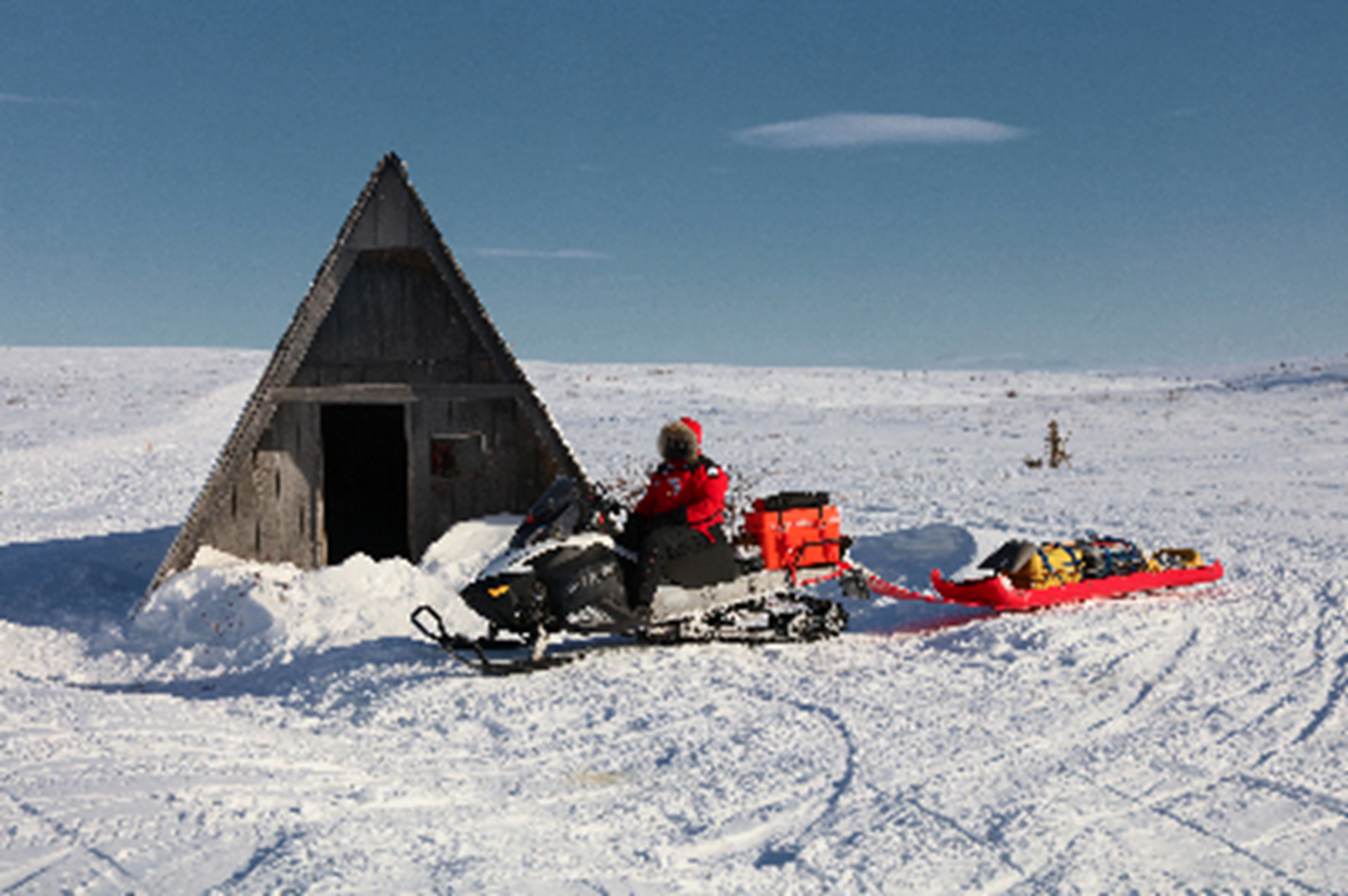
We packed up and rode onto the smooth ice of Golovin Bay at 10:15am. Our goal for this day was the Aurora Hotel in Nome and the Musher’s Banquet.
The trail was nearly perfect, and we ran along at speeds of between 25 and 30 mph.
We turned into the Fish River and followed it to White Mountain.
A few miles north of White Mountain the trail leaves water and makes a long run up and over the Topkok Hills. It’s all above the tree line and, with it’s spectacular rock outcrops jutting above the high, steep, rounded hills it makes for a gorgeous ride.
After the trail gets over the Topkoks, it drops down to the beach of Norton Sound at the Topkok Safety Cabin. From here it follows the beach all the way to the checkpoint at Safety. At Safety the trail takes the Polar Route over Cape Nome and into town, about 90 miles from Golovin. We made those 90 miles in under five hours.
Josh was ahead of me on the trail just outside of Nome when I saw him turn around and stop at something on the trail. It turned out to be a guy on a fat-tire bike. Lo and behold, here was Bjorn Olsen and, right behind him, was his girlfriend Kim. They had ridden up on their bikes just as Josh and I had re-mounted our steel sign at Rainy Pass in 2014. They became the very first people in a photo of the sign. We saw them several other times up the trail that year.
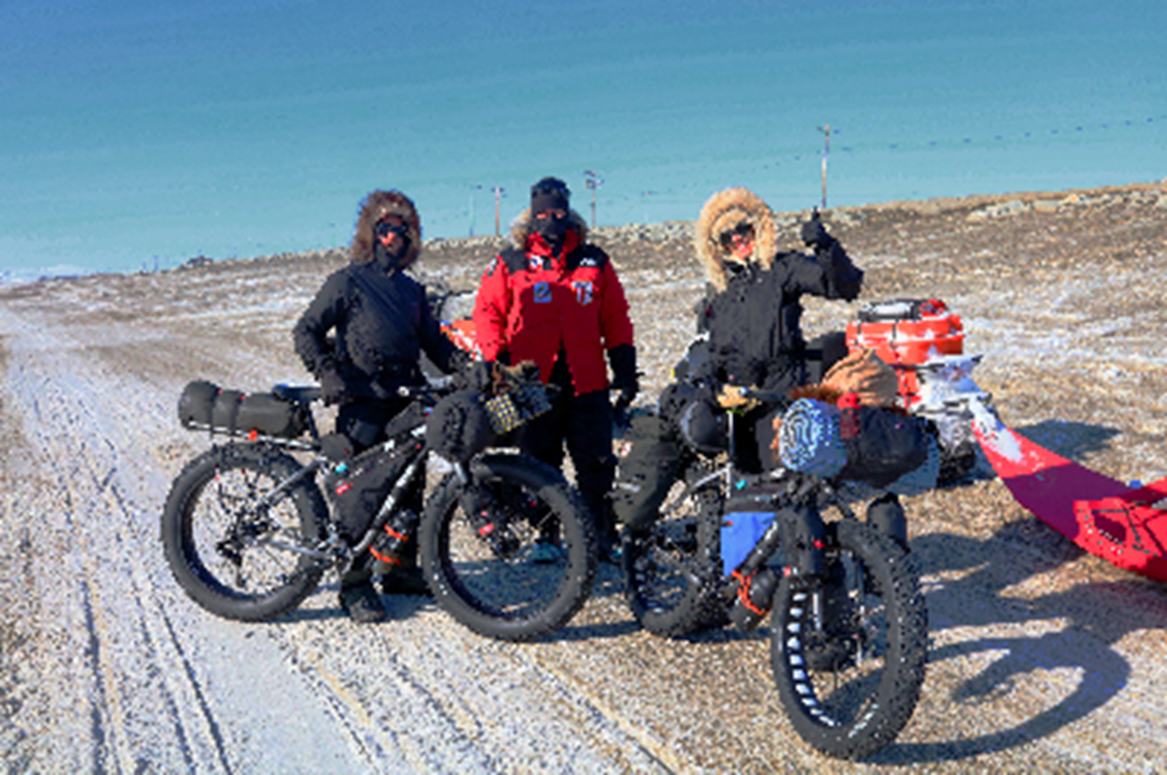
Now here they were, riding south out of Nome, on their way to Point Hope via Koyuk, Kotzebue and Kivalina, a distance of about 500 miles. It was great to renew those brief acquaintances for a few minutes on the trail. Hopefully we would see them again when we rode back to Unalakleet. They were equally thrilled to see Josh and I again. Kim told us that she has an uncle in Spokane that had seen my photo of them in Rainy Pass in the Spokane paper and sent it to her. It’s a small world!
One very interesting thing happened at Ruby which I’ll mention here:
Josh picked up a dog booty on the trail near Ophir that had a very small gadget inside and we surmised it could be a tracking device. He put it in with his gear. Then 150 miles later, in Ruby, we were having dinner with the Kanges family when the phone rang. Racheal answered, then handed the phone to Josh. It was a member of the Iditarod Committee calling from Unalakleet, 250 miles up the trail. It seems that they knew our exact location from the time Josh found the tracker until now! And they figured we were at Racheals….
When we got into the school in Shaktoolik, 200 miles later, one of the kids following the race knew we had stopped at the Foothills Cabin for a break!
We rode up in front of the Aurora Hotel at 3:30 p.m. and our room was ready. We had made it to Nome!
We moved in, spruced up a little and took a cab to the banquet where 1.400 people, along with most of this year’s mushers, were having a feast of all-you-can-eat prime rib, complete with all the trimmings, at the Nome Recreation Center.
We ate, then spent a most interesting evening watching this year’s awards being presented.
The 2016 Iditarod was over.
And tomorrow Josh will try to locate the proper owner of the tracking device he found.
***
One of the highlights of this trip is the reception we got in the little villages along the trail. We've only been here
three times in the past 6 years, yet the people remember us and are genuinely happy to see us again. In the 20 years I have ridden the trail, I have yet to have a single case of being offered a hand with a glove on it. Every man, woman and child ALWAYS removes their ever-present glove prior to shaking hands. Most of them offer: First, their name. Second:
"Welcome to (their village...): For instance:
"Hello! My name is Rich Landers. Welcome to Koyuk!"
They are cheerful. They are extremely intelligent. And they are gracious.
And they want to hear our tales of the trail....
They are an absolute pleasure!
***
Thoughts on the trip:
I guess I'd have to just say "It ain't getting any easier". At 76, my last Iditarod has to be in sight......this may be it.
I may have to call a halt with this Number 16: 25,000 miles on the long trail to Nome.
A person can only go so far on doses of ALEVE!
A guy could still fly up for the race, but it would be a hollow experience. I have never been much use as a tourist.
The ONLY way for me to experience this journey is from the seat of a snowmobile!
Who knows? I might get a giant injection of will-power and make myself lose some pounds and harden up some flab.....But that gets harder every year. The recliner is too inviting!
Josh is 40 years old. He is fired up. He is still in that fantastic condition of exploration. And, he wants to experience the South Route. He is a very convincing guy. Who knows what will happen in the next 12 months!
***
Most unique experience:
Josh picked up a dog booty near Ophir that had a little electronic gadget in it. He put it with his gear.
200 miles up the trail, in Ruby, we rented a little 2-bunk dry cabin from Racheal Kanges. Dinner was with her family, and while we ate the phone rang. Racheal answered the phone, then handed it to Josh. It was from one of the Iditarod personnel in Unalakleet, 250 miles further north. The device Josh had found was one of the musher's tracking devices, and they had been following our progress for three days! We had, in a sense, become a dog-team on the Iditarod Trail.
When we got the the school in Shaktoolik there was a big display modem on the wall which showed all the data of this year's race. A little girl came up and asked us if we had taken a break at a shelter cabin about 25 miles out of town. We had. She had been following our tracker and knew when we stopped for 30 minutes....The musher who had lost his tracking device was Bib No. 43, Larry Doughtery, a rookie from Eagle River, Alaska. He was in Nome for a couple of days while we came up the trail under surveillance. He finished in 63rd place.
